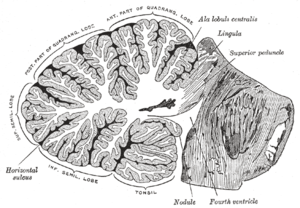Arbor vitae (anatomy)
| Arbor vitae | |
|---|---|
|
Figure shows Cerebellum and surrounding regions; sagittal view of one hemisphere. A: Midbrain. B: Pons. C: Medulla. D: Spinal cord. E: Fourth ventricle. F: Arbor vitae (in pink). G: Tonsil. H: Anterior lobe. I: Posterior lobe. | |
|
Sagittal section of the cerebellum, near the junction of the vermis with the hemisphere. ("arbor vitae" visible as white space to left, but not labelled.) | |
| Details | |
| Latin | arbor vitae cerebelli |
| Identifiers | |
| Gray's | p.791 |
| NeuroNames | hier-689 |
| NeuroLex ID | Arbor Vitae |
| Dorlands /Elsevier | a_56/12149382 |
| TA | A14.1.07.401 |
| FMA | 72541 |
| Anatomical terms of neuroanatomy | |
The arbor vitae /ˌɑrbɔr ˈvaɪtiː/ (Latin for "Tree of Life") is the cerebellar white matter, so called for its branched, tree-like appearance. In some ways it more resembles a fern and is present in both cerebellar hemispheres.[1] It brings sensory and motor information to and from the cerebellum. The arbor vitae is located deep in the cerebellum. Situated within the arbor vitae are the deep cerebellar nuclei; the dentate, globose, emboliform and the fastigial nuclei. These four different structures lead to the efferent projections of the cerebellum.[2]
The arbor vitae is subject to pathologies such as a cerebellar hemorrhage. Cerebellar hemorrhages arise from tumors, trauma and arteriovenous malformations among other things.[3] The cells in the arbor vitae could also be infected by pathogens which might cause lasting damage, this in turn could lead to cerebellar ataxia.[4]
Related
Godfrey Blount's 1899 book Arbor Vitae was ‘a book on the nature and development of imaginative design for the use of teachers and craftsmen’.[5]
External links
- Bioweb at UWLAX aplab
- Stained brain slice images which include the "Cerebellum" at the BrainMaps project
Additional Images
-
Arbor vitae
References
- ↑ Saladin, Keneth (2012). Anatomy and Physiology: The Unity of Form and Function. New York, NY: McGraw Hill. p. 526. ISBN 978-0-07-337825-1.
- ↑ Sodicoff, Marvin. "Cerebellum: Anatomy". Neuroanatomy Lab Resource Appendices. Temple University. Retrieved 11 December 2012.
- ↑ Huff, Stephen. "Pathophysiology". Cerebellar Hemorrhage. Medscape. Retrieved 11 December 2012.
- ↑ "Ataxia-causes". NHS Choices. British Government. Retrieved 11 December 2012.
- ↑ Blount, Arbor Vitae, 1899
| ||||||||||||||||||||||||||||||||||||||||||||||||||


